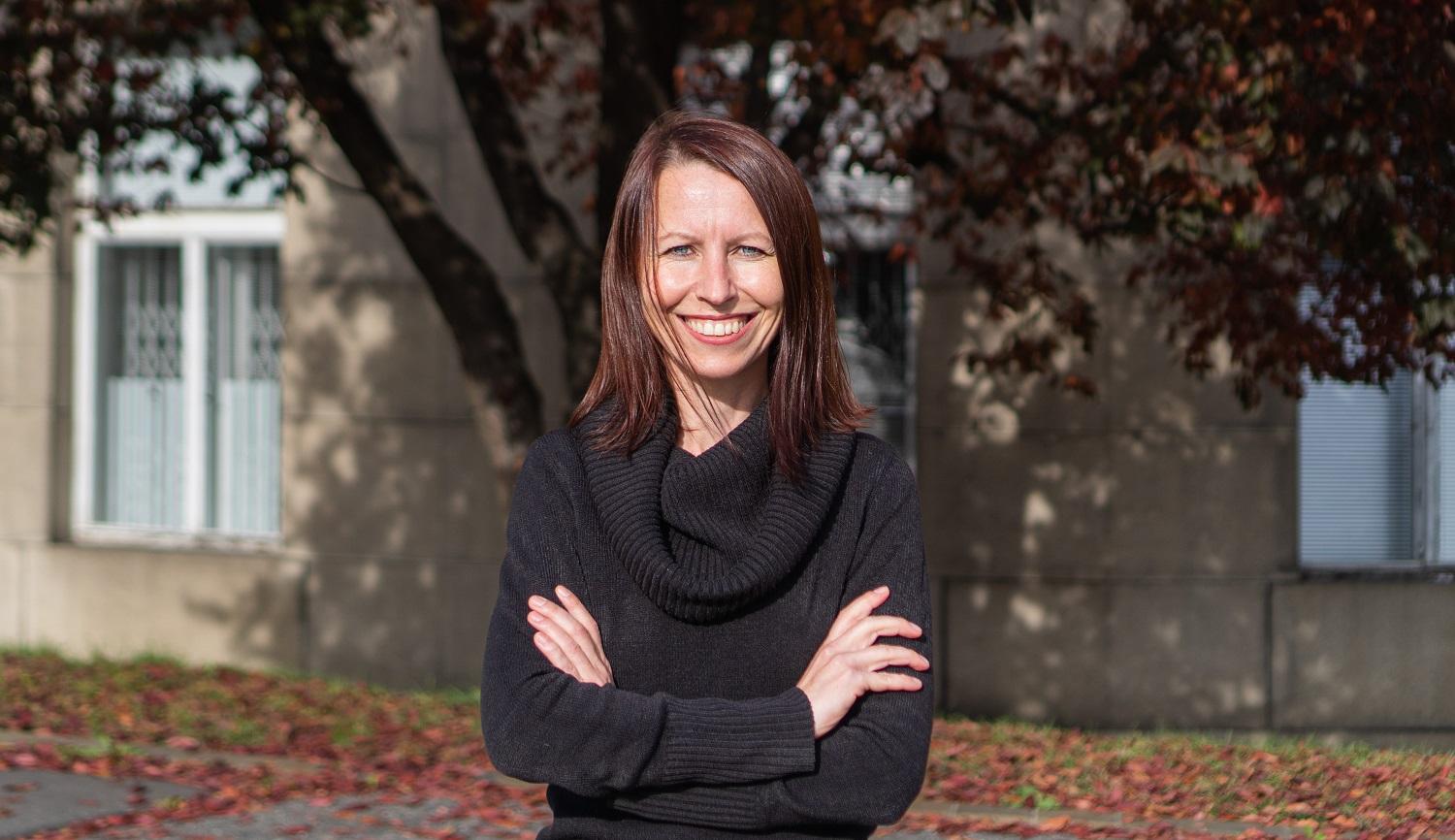
Krakatit 100: Another book by Jitka Čejková to mark the hundredth anniversary of Čapek’s work
Krakatit 100: Another book by Jitka Čejková to mark the hundredth anniversary of Čapek’s work Robot is the most famous Czech word worldwide, first used in Karel Čapek’s science fiction play R.U.R. In January 2024, MIT Press published the English version of UCT Prague Associate Professor Jitka Čejková’s book R.U.R and the Vision of Artificial Life (published in 2020 as Robot 100: Sto rozumů in Czech and launched at UCT Prague to an international crowd to mark R.U.R’s hundredth anniversary). It is an edited collection with contributions from one hundred contemporary voices, scientists and other scholars, explores the legacy of the play and its connections to the current state of research in artificial life, or Alife. Riding the wave of Čejková’s first book’s success, her new book, Krakatit 100, is to be published. In this interview, the author reveals to us the topic and the release date of the new book, as well as the names of the contributors.
Do you remember the first time you held one of Karel Čapek’s books in your hands? Which one was it?
When I was little, either Dashenka (Life of a Puppy) or Nine Fairy Tales: And One More Thrown in for Good Measure, not sure which one, but I’m sure I didn’t start with Krakatit.
What motivated you to write both books in addition to the anniversaries of R.U.R. and Krakatit?
Professor František Štěpánek once said in a BBC interview that the goal of his ERC project Chobotix (Chemical Robotics) was to make “chemical robots”. He mentioned that in R.U.R., Čapek described his robots as “a spittle of colloidal jelly that even a dog wouldn’t eat” and that thus, we at UCT Prague with our chemical robots are closer to the original concept of robots than any other kinds of robots today. I was his doctoral student at the time, and I borrowed this comparison of chemical robots to Rossum’s Universal Robots (R.U.R.) and began mentioning it everywhere (in presentations, articles, book chapters). It all culminated in the Robot 100 book and organizing the ALIFE 2021 artificial life conference here at UCT Prague.
In summer 2023, Zdeněk Vacek, Director of the Memorial of Karel Čapek in Strž, asked me if we should celebrate something again. We looked at what Čapek had published in 1924, and when we had to choose between Letters from England and Krakatit, the winner was clear. The idea for Krakatit 100 was born! Zdeněk prepared a traveling exhibition and I prepared the book. The connection between the Čapek’s novel and UCT Prague isn’t only that the hypothetical Krakatit explosive was prepared chemically: its fictitious creator, Engineer Prokop, could probably have been a UCT Prague alum, since in 1924, a chemist in Prague could obtain an engineering degree only at the School of Chemical Technology, one of the seven sections of Czech Technical University and UCT Prague predecessor. The name of a real professor, František Wald, who worked here, also appears in the novel.
How will Krakatit 100 differ from Robot 100? Will there be as many contributors?
Conceptually, the books are quite similar, but there are differences. Robot 100 featured R.U.R. in full with one hundred contributors (two-thirds international ones), but Krakatit 100 contains only the first three chapters of the novel with 32 contemporary voices (only seven from abroad). People from UCT Prague appear in the new book as well. Jan Budek from the Faculty of Chemical Technology’s Department of Organic Chemistry wrote about what Kratakit might be made from. I also managed to get three contributions from the Faculty of Chemical Engineering’s Department of Physical Chemistry: Vít Svoboda contributed a chapter (“Boom, chiky…chiky…boooom”), Štěpán Sršeň wrote “Confession of a scientist about scientific responsibility” and Pavel Matějka reflected on how Čapek’s work could influence real scientists, mentioning how Professor Zahradník once called a hypothetical molecule “cracatene”. Petr Šichtanc, UCT Prague architect from the Department of Operation and Technical Services, contributed “Professional deformation of an architect when reading Krakatit”. My colleague Petr Mazúr from the Chemical Engineering’s Department provided lyrics for the song “The Last on Earth” and will most likely sing his song at the book launch on November 28.
While UCT Prague’s Centre for Information Services published Robot 100: Sto rozumů, Krakatit 100 is being released as the first publication by the new publishing house Academix.
What can readers get most excited about?
I like all the contributions inside and I believe they will interest readers as well. Each text brings a slightly different point of view about Krakatit, and I don’t want to give any spoilers now. I can tell you that in addition to historical facts and scientific contemplations, there are also with fictional stories and song lyrics. Chemists, physicists, philosophers, Vědátor Project, health nutrition expert Eliška Selinger, science fiction author Julie Nováková, economist Jan Libich, linguist Karel Oliva, documentary filmmaker Petr Salaba, columnist Pavel Vachtl, and many others voices are included. My apologies that I can’t list them all.
I myself contributed to the book with a foreword as editor together with a commentary on my interview with Pavel Gregor. He is the only person I know who has experienced and survived a really big explosion and is willing to talk about it publicly. Piko (2010 film) was also about this topic. And this name suggests in Czech, the explosion occurred during meth production. Mr. Gregor was a user and producer of drugs, but he started a new life after the explosion. He studied psychotherapy and was an addiction specialist who helped drug addicts find their way out. He’s retired now and because he lost his sight in the explosion, he has a guide dog. And I, as a “pre-trainer” of prospective guide dogs, got to know Gregor from the events of the Club of Guide Dog Owners and the Jinonice Guide Dog Training Centre.
When will Krakatit 100 be released and where can you buy it?
It will officially be published on November 15, and Kosmas will take care of distribution to all bookstores. You can purchase the book in advance now in almost all Czech online bookstores. Since Krakatit 100 is being published with UCT Prague and our Rector Milan Pospíšil’s support as well as that of the Memorial of Karel Čapek, it will be, together with Robot 100, also available for purchase at UCT Prague (in the Respirium and during the Open House) and at the Memorial of Karel Čapek’s ticket office.
And I’d definitely like to recommend, if you haven’t read Krakatit yet or if it’s been a while, that you read it—also for better understanding of the connections with the contributions to the new book. I myself really like print books, so I advise you to go to a bookstore or second-hand bookstore to get a paperback edition of the Čapek’s novel (though I know that the eBook version is preferable to some; you can download it for free (in Czech) from the Municipal Library in Prague’s website).
One could say that Krakatit foresaw the atomic bomb. Do you also see a parallel in modern R&D? Which technologies do you currently have the most concerns about in terms of the potential to be misused?
I always find it amusing how often people refer to Krakatit as a science fiction novel that had anticipated the invention of nuclear weapons. But those who have seriously read Krakatit in full do not agree with this, and I also collected these opinions while preparing book. The first few chapters of Krakatit are full of technical terms and scenes from laboratories—even the auditorium of our predecessor, the School of Chemical Technology—but then things take a turn, and Ing. Prokop begins to yearn for an unknown woman, then he has a fling with Anči, then with Princess Willa, and eventually with Ludmila. Science and chemistry take a back seat to love and (for those times) erotic scenes. Krakatit is a story of passion, including a passion for science.
And to comment on parallels to current R&D—again, I don’t want to reveal too much to readers. There are contributions in the book that focus on weapons of mass destruction, including nuclear weapons. While powdered Krakatit was invented by a fictional chemist, real atomic bombs were later created by physicists. Questions about artificial intelligence (AI) also resonate through the book in several essays. Personally, I am not at all afraid that AI or a similar technology could destroy us; I’m more afraid that humanity will destroy itself by becoming too used to convenience and perish in dullness.
What do you and your UCT Prague research group do? Is your work somehow related to the content of these two books?
As I mentioned here, I started in František Štěpánek’s Chobotix group and we worked on the design and preparation of microscopic chemical robots. Later, I focused on investigating larger objects, droplets, which also work exclusively, purely, according to chemical principles, like Rossum’s R.U.R. robots. I call them “liquid robots”. Like living cells, for example, they can move chemotactically, that is, they follow chemical substance signals or change shape and, like cells, create different stalks, or even the growth of so-called myelin figures can be observed at the microscopic level. Our droplets can behave collectively or act as miniature engines. My research falls into the scientific field of artificial life. Robot 100 had a lot to do with my work; Krakatit 100 only peripherally. I really identify with some of Čapek’s statements in his writing. For example, people often ask scientists what their research is good for? And sometimes, the necessity of basic research is really hard to justify. And I like how beautifully Engineer Prokop in Kratakit answered the question “Why would you do that?”: “Because it’s scientifically interesting!”
Will you follow up with another book about another Karel Čapek work?
I definitely want to publish The Life of a Puppy 100 and Newt 100, but that won’t happen until 2033 and 2036. In any case, I’ve already started approaching potential contributors so that no one can make excuses about not having enough time to prepare. So I hereby invite students and colleagues to contact me if they want to have a text in these future books. Otherwise, I’m going to take a break from Čapek and the number 100 for a while; I promised to be the editor of the book ALIFE 40 marking the fortieth anniversary of the scientific field artificial life. The first artificial life conference was held in Los Alamos in the United States in 1987, and I will very likely organize ALIFE 2027 conference, to be held in Prague, including the launch of the ALIFE 40 book. I am looking forward to it. You should look forward to it too!







